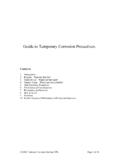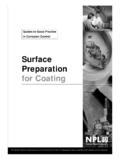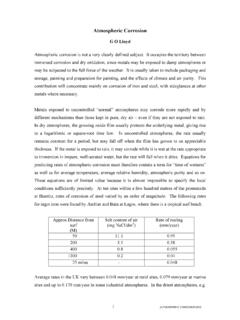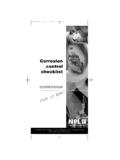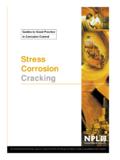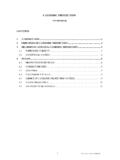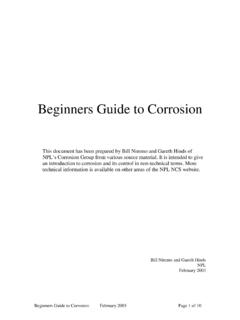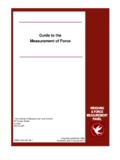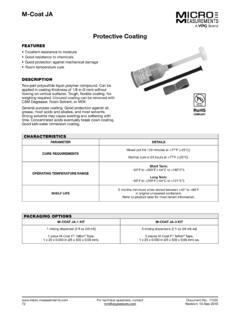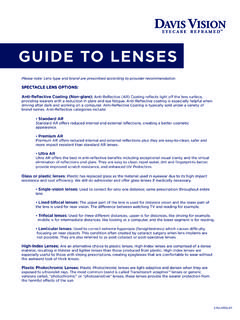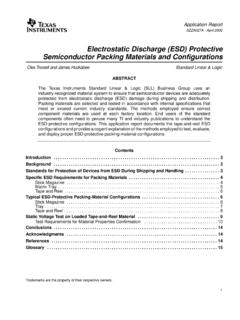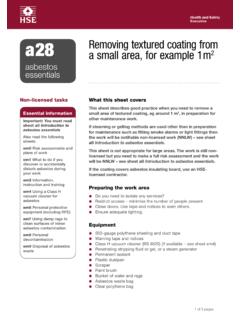Transcription of Coating for the Protection of Structural Steelwork
1 2295/aaron/IK/0004 Guides to Good Practice in Corrosion ControlThe National Physical Laboratory is operated on behalf of the DTI by NPL Management Limited, a wholly owned subsidiary of Serco Group plcCoating forthe Protectionof StructuralSteelworkContents pageCoating for the Protectionof StructuralSteelworkThis is an update of a DTI publication first issued in 1982. The new versionhas been prepared by Dr. R. Hudson of Corus Group plc under contractfrom NPL for the Department of Trade and requirements for protecting the protective paint (intermediate coats)
2 Main constituents of generic types of paint4& their drying chemical resistant chemical resistant of epoxy silicate application of Conditions of Metallic Hot dip Thermal spray Specifying the protective Factors affecting Writing the Health & Environmental Additional reference reading12& further sources of informationAdditional reference reading12further sources of information12oneCoatings for the Protection of Structural purpose of this guide is to explain, in terms of modernconcepts, the basic requirements for protecting structuralsteel with paint and metallic coatings, the systems commonlyused and their significance in relation to the protective properties required.
3 The emphasis is on the Protection ofonshore structures, such as buildings, bridges, factories, andindustrial plants in which the process environment contributesto the corrosion is made to appropriate standards which deal withalternative protective systems in detail. These documents area very valuable source of information and it is recommendedthat they should be consulted freely at an early stage in theselection of a protective is given to the important influence of applicationmethods on the efficiency of the Protection achieved, and onthe need for strict inspection procedures.
4 Guidance is alsogiven on procedures to be used when drafting specifications,and on the health and safety and environmental protectionrequirements to be observed. requirements for protecting steelSteel will rust only if water and oxygen are both present andthe rusting process is greatly accelerated by pollutants in theatmosphere, such as sulphur dioxide from the burning of oil,coal, or gas and chlorides from de-icing salts or marineatmospheres. Solid pollutants can be hygroscopic and maypromote localised attack ( corrosion pitting) at specificpoints on exposed steel.
5 Protective systems must be resistantto attack by such pollutants and should be applied only to surfaces from which they have been importance of surface preparation is paramount to allcoating systems and for painted surfaces is dealt with inGuide No. 13 in this series: Surface Preparation for Coating .To ensure good Coating adhesion, it is essential that the surface to be coated is rendered free of dirt, dust and debristhat might affect performance. Water-soluble residues, if lefton the surface, will cause rapid deterioration at the interfacewith paint when the Coating is exposed to is the most commonly used material to protect steel,and in practice the term, paint covers a wide range of materials with different properties.
6 The application of paint iscomparatively easy with no limitation on the size of steelworkthat can be paints have been developed to provide improvedproperties over their predecessors. However, the benefit ofthese improvements will only be achieved by careful attentionto important factors such as surface preparation, the selectionof a suitable paint for the specific situation, and correct Structural Steelwork the paint film thickness is importantfor lasting Protection since it is difficult to obtain perfect application under construction conditions.
7 Best results areobtained when coatings are applied in heated enclosed workshops; units for bridge structures and building frameworkcan be coated in this manner before erection and additionalcoats may be applied on site, where Coating facilities can automatically blast clean andprime Steelwork before departure to improved resistance to mechanical damage or betterdurability in certain environments is required, coatings of non-ferrous metals such as zinc or aluminium can be usedinstead of paint coatings, although this may incur increasedcost.
8 The combination of metallic and paint coatings can provide very long term durability in aggressive environmentsand an aesthetically pleasing the protective systemOne of the most widely referenced guides to the selection ofprotective systems for steel has been BS 5493 , in recent years, new standards for paint and metalcoatings have been developed. These are EN ISO 12944 Parts 1 to 8 Paints and Varnishes - Corrosion Protection ofSteel Structures by Protective Paint Systems and EN ISO14713 Protection Against Corrosion of Iron and SteelStructures - Metal Coatings - Guidelines.
9 These standards classify common types of environments and related corrosivitycategories and provide an indication of life to first maintenance of the protective system in each lives to first maintenance are:Very long:20 years or moreLong:10 to 20 yearsMedium:5 to 10 yearsShort: less than 5 yearsFor very long life , the systems are thick hot dip galvanizingor thermal (metal) spraying with an appropriate sealing coatof paint. For long and medium life, selected high performancepaint systems are suggested.
10 Paint systems based on dryingoils are suitable only for short life to first maintenance inaggressive environments, but are included in the long andmedium life in non-polluted exterior and certain interior environments. In dry interior environments, the corrosion riskis insignificant and no protective Coating is necessary. Painting may, however, be required for decorative or appearance purposes. The transition from medium to long lifeto first maintenance is achieved by additional film thickness,provided that the finish maintains the necessary appearanceand weathering systems depart from the conventional primer/under-coat/finish systems.
